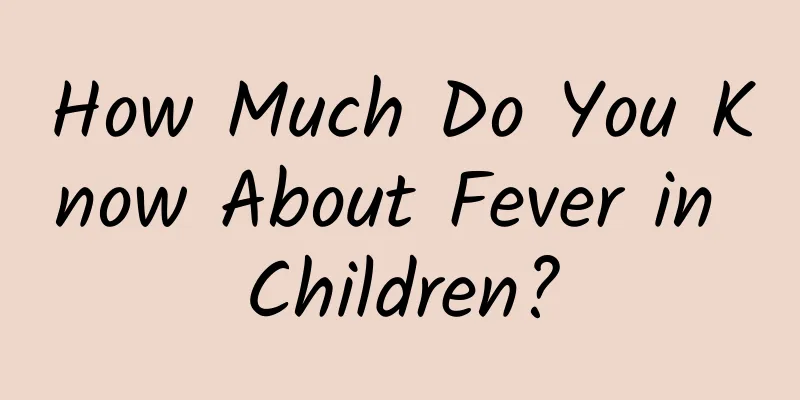How Much Do You Know About Fever in Children?

|
Fever is one of the most common clinical symptoms in children and the most common reason for children to visit outpatient and emergency departments of medical institutions. The main cause of acute fever in children is infectious diseases. Most acute fever in children is caused by some self-limiting viral infection and has a good prognosis. However, some fevers are caused by serious bacterial or viral infections, which can lead to serious consequences if not treated in time. Therefore, fever in children often causes worry and anxiety for parents or caregivers. Here are some of the questions that parents most want to know about fever in children, hoping to help parents. What is fever? What is the body temperature of children considered to have a fever? What is a high fever? Fever refers to the body temperature rising beyond the normal range under the action of pyrogens or various reasons that cause dysfunction of the body temperature regulation center, that is, the body temperature rises beyond the upper limit of normal body temperature fluctuation in a day. Body temperature is divided into surface temperature such as axillary temperature, ear temperature, forehead temperature, and core temperature such as oral temperature and rectal temperature. The temperature of different parts is different. The normal body temperature of an individual is also slightly different, and the fluctuation is less than 1°C in a day. In clinical work, fever is usually defined as a rectal temperature ≥ 38℃ or an axillary temperature ≥ 37.5℃. Abnormal body temperature is also considered a manifestation of disease. Because axillary and sublingual temperatures are affected by many factors, rectal temperature can truly reflect the body temperature. Therefore, when the rectal, axillary, and sublingual temperatures differ greatly, the rectal temperature should be used as the standard. Mercury thermometers are easily damaged and cause harm, and leaked mercury can cause poisoning and environmental pollution, so they are rarely used now. Measuring oral and rectal temperatures often causes discomfort due to the insertion of the thermometer, which is not easily accepted by children. At present, the most commonly used thermometer in clinical practice is the electronic thermometer, and the body temperature is measured in the axillary area. Clinically, fever is divided into four categories according to the body temperature. Based on the axillary temperature, 37.5-38.0℃ is low fever, 38.1-38.9℃ is moderate fever, 39.0-40.9℃ is high fever, and ≥41.0℃ is hyperpyrexia. Children with prolonged high fever and hyperpyrexia are prone to convulsions and organ damage. Parents should pay special attention to prevent children from prolonged high fever and hyperpyrexia. The second question is how to deal with children's fever. Do all fevers need to be treated with antipyretics? At what temperature should physical cooling be used for children? At what temperature should antipyretics be used and how much should be used? How long after opening is it not recommended to use antipyretics? The main purpose of antipyretic treatment is to relieve the discomfort caused by fever, that is, to improve the comfort of children, rather than simply restore the normal body temperature of children. Therefore, if the baby's body temperature reaches 39℃, but the spirit is very good, it does not affect playing, the appetite is also very good, and there is no obvious discomfort in the body, you can temporarily stop taking antipyretics, drink more water, and continue to observe. If the body temperature is less than 38℃, but the baby is in a bad spirit, has a poor appetite, is generally uncomfortable, and has muscle aches, then antipyretics can also be used at this temperature. For babies with a history of high fever convulsions, antipyretics should be more active. High fever convulsions usually occur within 24 hours of the onset of fever, so it is best to actively reduce fever within 24 hours of the onset of fever. Antipyretic drugs can be used when the temperature exceeds 37.5 degrees. When the body temperature exceeds 41℃, the protein in the body will decompose, which can cause cerebral edema and cause the death of the sick child or leave sequelae of encephalopathy. Therefore, children must be treated urgently when they have a high fever above 40℃. If children have a fever, especially if the baby has any abnormal conditions, you must seek medical attention in time or consult a doctor online for help, and actively find and treat the cause of the fever. For children with low to moderate fever, when the body temperature is between 37.5 and 38.9℃, proper care and physical cooling can improve the comfort of the children. For example, warm water compresses on the forehead of children, warm water baths, reducing the amount of clothing worn, fever patches, cooling blankets, fans, and lowering the indoor temperature, etc. These methods can take away the body's heat through conduction, convection, and evaporation, making children with fever feel comfortable. Physical cooling is mainly used to reduce fever in newborns and infants, such as undressing, adjusting the room temperature to 22-24℃, or warm water baths. When cooling physically, follow the principle of cooling with cold and cooling with warmth, that is, those with high fever and hot limbs but no chills should be given cold water baths, ice compresses, etc.; those with fever and cold limbs, chills, and chills should be given 30-35℃ warm water baths until the skin turns red and warm. In the past, some people recommended that parents use 30% to 50% warm alcohol for bathing, but because alcohol can damage the structure of the skin hair follicles and affect the skin's heat dissipation function; and alcohol can be absorbed through the skin and damage liver function, pediatric experts now recommend that it be banned. Other methods such as ice water enema often significantly increase the child's discomfort and are currently not recommended for children. When physical cooling is ineffective, drugs can be used to reduce the temperature. Children's antipyretics should be selected from drugs with clear efficacy, reliable safety, and few side effects. Acetaminophen, ibuprofen, etc. are commonly used. For children with fever, antipyretic drugs are symptomatic treatment, and the main purpose is to relieve the patient's discomfort. When the patient has no discomfort, is in good general condition, and has no history of high fever convulsions, it is not necessary to use antipyretics immediately, but close observation can be performed. Antipyretics should not be used to reduce the temperature of children aged <2 months. For children with fever, the Wong-Baker Facial Expression Pain Scale can be used to assess the comfort of children during acute fever. If the fever shows slight pain, antipyretics can be considered. Acetaminophen, also known as paracetamol, is recommended by WHO as the first choice drug for fever caused by acute respiratory tract infection in children. The minimum applicable age is 2 months, and the recommended dose is 10-15 mg per kg of body weight per dose; the main route of administration is oral administration, and those who cannot take it orally can choose to insert the suppository into the rectum; it can be used repeatedly every 4-6 hours, not more than 5 times a day, and the course of treatment is not more than 5 days. For those under 3 years old, the maximum dose is less than 250 mg per time. There are few side effects, and nausea, vomiting, and allergic reactions are common. Overdose can cause liver damage and even liver necrosis; liver and kidney dysfunction or large-scale use may cause side effects such as thrombocytopenia, jaundice, and azotemia. The minimum age for ibuprofen is 6 months, and the recommended dose is 5-10 mg per kg of body weight per dose. The interval is 6-8 hours, no more than 4 times a day. It is mainly taken orally, has antipyretic, analgesic and anti-inflammatory effects, and can improve the comfort of those with fever. If oral administration is not possible, anal suppositories can be used, and it can also be administered intravenously. Common side effects include nausea and upper abdominal discomfort, and a few have headaches, tinnitus, dizziness, skin allergies, and thrombocytopenia; use with caution in patients with heart failure; patients with urinary retention, edema, and renal insufficiency may develop acute renal failure. It is generally not recommended to use antipyretic drugs for more than 1 month after opening. Question 3: How to use ibuprofen and acetaminophen when children have fever? Can they be used at the same time or alternately? Do not use them simultaneously or alternately. Both acetaminophen and ibuprofen inhibit the hypothalamic temperature regulation center to reduce fever. Although the combination of acetaminophen and ibuprofen can reduce body temperature slightly more than acetaminophen or ibuprofen alone, it has no significant clinical significance and cannot improve the comfort level of the child; and the combined use of the two drugs increases the risk of adverse drug reactions. Therefore, it is not recommended to use the two drugs in combination or alternately for antipyretic treatment. At the same time, it is not recommended to use compound cold medicines containing the same drug ingredients in combination to avoid repeated medication and even the risk of drug overdose. Question 4: Are children with high fever necessarily more seriously ill than children with low fever? Children with high fever and children with low fever cannot be judged as more serious simply by the temperature. Because the causes of fever are different, the symptoms are different. If you simply compare the body temperature, the body temperature is higher in high fever than in low fever, which may cause dehydration or electrolyte imbalance in children, or the chance of febrile convulsions is relatively higher. However, in terms of diseases that cause fever, diseases that cause high fever are not necessarily serious diseases, and low fever is not necessarily a mild disease. For example, the more common leukemia, tuberculosis, or some serious infectious shock, or children with low immunity may only have a low fever, but the disease is more serious; on the contrary, roseola infantum manifests as a high fever, but the disease itself is not serious. |
<<: Do you really understand hypoglycemia?
>>: Reminder! 10 things you must know after the test turns negative
Recommend
Why does my belly get fatter before my period?
The abdomen is a part that women pay close attent...
Anesthesia needle pain after cesarean section
Pregnant women who have caesarean sections must c...
What is the effect of eating pig's trotters? How to make pig's trotters delicious
We all know that pig's trotters are rich in c...
Will ovulation occur on the 13th day of menstruation?
Women all have an ovulation period, which can be ...
Reasons for craving for food before menstruation
Menstruation is a magical thing. People think tha...
Is less body hair a blessing or a curse for women?
Question 1: Are some women depressed because they...
Symptoms and treatment of advanced breast cancer
In recent years, breast cancer has become particu...
What are the obvious symptoms of uterine cold during pregnancy
Women are inherently yin, so their bodies are mor...
Will my belly swell during pregnancy?
Pregnant mothers become the focus of protection i...
I lost weight by not eating dinner during late pregnancy
Most women love beauty. Many pregnant women have ...
What kind of checks are needed for abortion?
Pregnant women who want to have an abortion need ...
What to do if your vagina smells
Women's physical health can be affected by va...
Can I eat dried radish during menstruation?
Dried radish is made from radish. We cut the whit...
What is watery leucorrhea?
Women's reproductive health issues require sp...
What fruits can I eat when I have my period?
Women need to pay attention to their diet during ...
![[Doctors Talk] The labor process is divided into three stages, and each stage has its own characteristics.](/upload/images/67f17b3576a95.webp)








